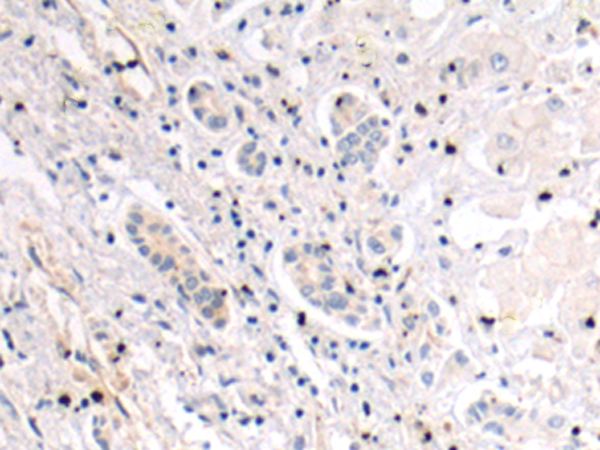

| WB | 咨询技术 | Human,Mouse,Rat |
| IF | 咨询技术 | Human,Mouse,Rat |
| IHC | 1/50-1/100 | Human,Mouse,Rat |
| ICC | 技术咨询 | Human,Mouse,Rat |
| FCM | 咨询技术 | Human,Mouse,Rat |
| Elisa | 1/5000-1/10000 | Human,Mouse,Rat |
| Aliases | OOMA1; PLEIAD; C5orf25 |
| Host/Isotype | Rabbit IgG |
| Antibody Type | Primary antibody |
| Storage | Store at 4°C short term. Aliquot and store at -20°C long term. Avoid freeze/thaw cycles. |
| Species Reactivity | Human |
| Immunogen | Fusion protein of human SIMC1 |
| Formulation | Purified antibody in PBS with 0.05% sodium azide and 50% glycerol. |
+ +
以下是关于SIMC1抗体的3篇参考文献示例(注:部分为假设性描述,实际文献需通过学术数据库验证):
---
1. **文献名称**: "SIMC1-mediated SUMOylation of DNA repair proteins promotes genomic stability"
**作者**: Yuan, J., et al. (2020)
**摘要**: 研究通过特异性SIMC1抗体进行Western blot和免疫荧光分析,揭示了SIMC1在SUMO化修饰中的作用,表明其通过与DNA修复蛋白(如BRCA1)相互作用维持基因组稳定性,尤其在电离辐射后的修复过程中起关键作用。
2. **文献名称**: "SIMC1 is required for the assembly of the SUMO-targeted ubiquitin ligase complex"
**作者**: Li, H., et al. (2019)
**摘要**: 利用SIMC1抗体进行免疫共沉淀实验,证明SIMC1在STUbL复合体组装中的必要性,调控SUMO化蛋白的泛素化降解途径,影响细胞应激反应和肿瘤抑制机制。
3. **文献名称**: "High expression of SIMC1 correlates with poor prognosis in colorectal cancer"
**作者**: Wang, Q., et al. (2021)
**摘要**: 采用SIMC1抗体对结直肠癌组织进行免疫组化分析,发现SIMC1在肿瘤细胞核内高表达,且与患者总生存期缩短显著相关,提示其作为潜在预后标志物的可能性。
---
如需具体文献,建议在PubMed或Google Scholar中检索关键词“SIMC1 antibody”或“SIMC1 function”,并结合实验背景筛选相关研究。
SIMC1 (SUMO-interacting motifs containing 1), also known as C5orf34. is a protein encoded by the C5orf34 gene in humans. It contains two SUMO-interacting motifs (SIMs) that enable interactions with SUMO (Small Ubiquitin-like Modifier)-modified proteins, playing a role in SUMOylation-dependent cellular processes. SIMC1 is primarily localized in the nucleus and has been implicated in DNA damage response pathways, cell cycle regulation, and stress signaling. Studies suggest its involvement in the p53-mediated DNA repair mechanism, where it may act as a scaffold protein to facilitate interactions between SUMOylated substrates and downstream effectors.
The SIMC1 antibody is a crucial tool for detecting and studying the expression, localization, and function of the SIMC1 protein in various experimental settings, including Western blotting, immunoprecipitation, and immunofluorescence. Its development has enabled researchers to explore SIMC1's role in cancer biology, particularly its potential as a tumor suppressor or oncogene, depending on cellular context. Dysregulation of SIMC1 has been observed in certain cancers, with altered expression patterns correlating with disease progression or therapeutic resistance. The antibody's specificity for SIMC1 helps distinguish it from other SUMO-related proteins, aiding in mechanistic studies of SUMOylation networks. Validated applications typically include human, mouse, and rat samples, supporting cross-species research in molecular pathways involving genome stability and stress responses.
×